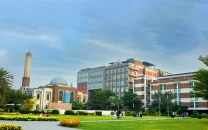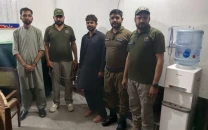Monks ring ‘peace bell’ to mark Buddha’s birthday
Global delegates gather at Taxila, immerse themselves in ancient Gandhara heritage
1717094574-0/Buddhist-leaders-Taxila-Museum-(8)1717094574-0-640x480.webp)
International delegates comprising Buddhist monks, diplomats, and academics Thursday rang the ‘peace bell’ installed at the Taxila Museum, heralding the news of peace and prosperity in the region.
Buddhist leaders from various countries visited the Taxila Museum and performed religious rituals.
1717094575-3/Buddhist-leaders-Taxila-Museum-(5)1717094575-3.jpeg)
On the occasion of Buddha’s birthday, the Ministry of Foreign Affairs organised a two-day Vesakh ceremony. Buddhist monks from many countries, including Sri Lanka, Maldives, Thailand, Indonesia, and Vietnam, along with Buddhist scholars, and other guests, participated in the ceremony.
After the two-day conference in Islamabad, the delegation visited the Taxila Museum, Sirkap, Mohra Muradu, and Bhamala Stupa. At the Taxila Museum, prayers for peace and prosperity in the region were offered by ringing the bell of peace on the occasion of Buddha's birthday. Buddhist monks from Thailand and Sri Lanka initiated the Buddha's birthday celebrations by ringing peace bells, which were installed by the Thai government a few years ago.
1717094574-1/Buddhist-leaders-Taxila-Museum-(7)1717094574-1.jpeg)
Besides the Taxila Museum, the delegation visited Sirkap, Julian, and Bhamala Stupa, performing religious rituals at each site.
Read also: Foreign delegates visit ancient Buddhist sites
On this occasion, Director of Taxila Museum Anjum Dara, while talking to The Express Tribune, said that the arrival of a world-class delegation on Buddha's birthday is proof that Pakistan is a peaceful country, which will not only promote tourism but also increase opportunities for cultural diplomacy and bilateral trade.
1717094574-6/Buddhist-leaders-Taxila-Museum-(2)1717094574-6.jpeg)
He further said apart from tourists from Buddhist countries, a large number of delegations from Britain, Europe, Japan, and America also visit to see the remains of the Gandhara civilisation. The Department of Archeology utilises resources to provide all possible facilities.
Speaking to The Express Tribune, a Thai monk said that the Buddha remains preserved in the Taxila Museum hold great religious importance to them, and no other museum in the world has such a collection of Buddhist relics. This land is very sacred to them religiously, which is why information and subjects related to Gandhara art and Taxila are included in the regular curriculum in their country.
1717094574-5/Buddhist-leaders-Taxila-Museum-(3)1717094574-5.jpeg)
Minister of Culture and Foreign Affairs of Sri Lanka, Wickramanayaka, expressed gratitude to the government of Pakistan for preserving all Buddhist objects and historical remains in an excellent manner, which will be very helpful for future generations to read and understand Buddhist culture.
Archaeology expert Syed Gul Kailash mentioned that the guests were given a tour of Bhamala Stupa. All the guests in the delegation thanked the Government of Pakistan and the Department of Archeology for cleaning and preserving the Bhamala Stupa in a very professional manner. He added that they always strive to showcase the Gandhara culture to the whole world.
1717094574-7/Buddhist-leaders-Taxila-Museum-(1)1717094574-7.jpeg)
The great cultural heritage of Taxila is not only a historical fact but also a memorable relic of ancient times, showcasing astonishing examples of knowledge and artistry from bygone eras that remain thought-provoking for modern-day individuals.
Read: Buddhists visit Julian Stupa in Haripur
The Gandhara civilisation was an empire between five and seven hundred years before Christ, encompassing parts of northern Pakistan, Kashmir, and Afghanistan. Most of the population of this state was in the Potohar Plateau, Peshawar, and the areas bordering the Kabul River.
1717094574-4/Buddhist-leaders-Taxila-Museum-(4)1717094574-4.jpeg)
The delegation was informed that the study of history shows that the Gandhara civilisation experienced the rise and fall of the empire from six hundred years before Christ to the eleventh century AD. British soldiers and officials began to take an interest in the ancient history of the subcontinent in the 19th century. In 1830, some coins of Ashoka's era were discovered here.
The investigation of some Chinese historical books and these coins helped to trace the archaeology in the vicinity of Taxila in 1860. Excavations from 1912 to 1934 revealed numerous ancient cities, stupas, and places of worship.
1717094574-2/Buddhist-leaders-Taxila-Museum-(6)1717094574-2.jpeg)
The revelations made it possible to understand Gandhara's science, arts, and history. Today, Khanpur Haripur Taxila Jaulian houses the remains of all these Gandhara settlements, constructions, and religious pilgrimages, attracting followers of Buddhism from around the world.
WITH ADDITIONAL INPUT FROM YAWAR HAYAT.
Published in The Express Tribune, May 31st, 2024.



















COMMENTS
Comments are moderated and generally will be posted if they are on-topic and not abusive.
For more information, please see our Comments FAQ